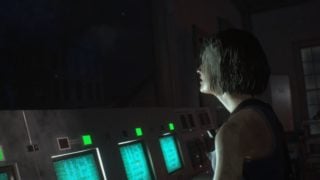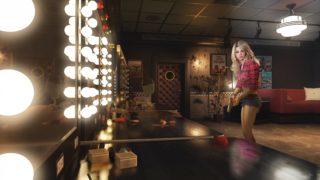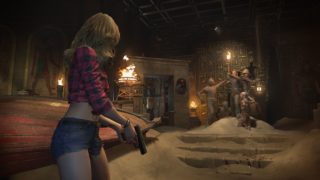Hands-On: Resident Evil 3 is another intelligently assembled remake
Raccoon City comes to vibrant, chilling life in Capcom’s latest rework

At some point, any player no longer in the first flush of youth will have pondered a dream scenario: imagine what would have happened if developers in the 1990s, conspicuously awash with imagination, had had access to the sort of technology available to developers in the 21st century?
Last year, Capcom answered that question in emphatically impressive style, with its remake of Resident Evil 2 (VGC’s Game of the Year 2019). Now – showing an admirable refusal to rest on its laurels – Capcom is preparing to release Resident Evil 3 Remake on April 3.
The Japanese developer/publisher has applied similar methodology to the 1999 game – which arguably set the blueprint for all subsequent Resident Evil games by escaping from the confines of claustrophobic interiors for the first time – to that used for Resident Evil 2. So, it has reimagined Resident Evil 3 in full 3D using the Resident Evil 7 engine and, it claims, has been unafraid to add new elements and tweaks, while attempting to preserve the essence of the original.
We managed to experience a roughly two-hour chunk of Resident Evil 3 Remake’s single-player campaign, which proved to be enough to confirm that Capcom appears to have achieved those aims. Starting roughly 30 minutes into the main storyline, we took control of Jill Valentine in Raccoon City’s subway station, armed initially with a pistol, a bit of ammo and precious little else. Which gave us a chance to admire Jill’s high-resolution makeover (particularly in evidence during cut-scenes), take in the over-the-shoulder viewpoint (identical to that of Resident Evil 2 Remake) and scavenge around for some essential items.
In Brief: Resident Evil 3 remake
- What is the Resident Evil 3 remake release date? April 3, 2020.
- What is Resident Evil 3’s multiplayer? Resistance is a separate 4v1 online mode.
- Will Mercenaries mode return? Mercenaries will not return.
Squeezing underneath the station’s metal barrier brought a nostalgia-rush which instantly took us back to playing the original game. Resident Evil 3 was the first game in the series that put us on the streets of Raccoon City, reduced to chaos following the T-Virus outbreak, and the Remake provides a similarly revelatory moment since the move from the original’s pre-rendered backgrounds to full 3D has brought a whole new level of vibrancy and immersion to Raccoon City.
Zombies shamble aimlessly, shops are illuminated in an incongruously cheery manner with neon, and the original’s trademark red explosive barrels, augmented by sparking generators which also unleashed area effects when shot, abound.
Still recognisably Resi 3
It swiftly became obvious that while going to town with Raccoon City’s level design, Capcom has resisted some urges to modernise the game in ways that would have altered its inherent nature.
Jill Valentine still moves in a pretty clunky manner: her run is more of a fast walk, and aiming is still a slow, low-snap process. And Resident Evil 3 Remake is still far from a semi-open-world game in, say, the manner of Resident Evil 5: while players can explore shops and alleyways (something of a risk without plenty of ammo with which to dispose of surrounding zombies), it still steers you on a tortuous path in the pursuit of solutions to various puzzles.
The first puzzle we encounter involves a fire raging in an alleyway which we clearly need to navigate. A fire hydrant adjacent to the blaze requires another object in order to function, so we embark in search of that, timing our barrel-hits to take out as many zombies as possible. If Jill is grabbed by zombies, she can wrestle herself free with some button-bashing, as long as her health isn’t firmly in the red zone.

Exploration of a path up stairs and through a building takes us to another part of the map, where we find the subway company’s office – the presence of a shotgun there in a cupboard, secured with a chain, suggests we will have to return there later, with another key item. All the objects you would expect to find in a Resident Evil game are present and correct – coloured herbs, ammo, gunpowder for crafting ammo, a grenade and various coloured jewels hidden in boxes.
Finding a fire-hose, we returned to the first alleyway, extinguished the fire and are rewarded with a pair of bolt-cutters. Returning to grab the shotgun – a vast upgrade on the basic handgun – we make our way to a newly accessible garage, where a cut-scene plays, involving UBCS operative Carlos and bringing a new mission: to restore power to the subway system and set the points to allow a train to move from the nearby station to a different part of the city.
The bolt-cutters opens up a new, labyrinthine, sinisterly cobwebbed area containing four breakers which have to be flipped to get the power back on; giant spiders provide an obstacle. They will poison Jill with each bite; healing her, amusingly, causes her to vomit. Making our way back to the subway company office brings our first encounter with Resident Evil 3’s notorious Nemesis, a huge, black-leather-clad, more or less indestructible individual equipped with tentacles with which he can drag Jill towards him for terminal punishment.
“Like the Resident Evil 2 Remake, it simply feels like a fantasy version of the original game. Which is great news for fans not just of Resident Evil but of survival-horror games in general.”
Shooting barrels and generators immobilises him long enough for Jill to run away; back at the subway offices, another puzzle sets up the last remaining train as a means of escape. Time to regroup at the station, after again evading the Nemesis, where we are able to cash in the coloured jewels for useful items (including an improved stock for the shotgun). A cut-scene there brings more UBCS operatives (with the exception of Carlos, hostile towards Jill) into play, but Jill is dispatched to the sewers, in order to escape the ever more present Nemesis.
There, we encountered a new enemy, the Hunter Gamma – with a more giant-chicken-like shape than the original game’s anthropomorphic Hunter Betas. They can only be damaged by shots to their giant, alien-like mouths, but prove susceptible to grenades – handily, we find the grenade launcher. A recurring puzzle in the sewers centres on electrical doors that require a reusable power source. The level – and hands-on play – ends with another showdown with Nemesis.

If you played Resident Evil 2 Remake, you’ll have more than an inkling of what to expect from Resident Evil 3 Remake: like last year’s effort, it preserves the general feel and ambience of the original game, while clothing it in gorgeous visuals (that have the by-product of ramping up the general level of creepiness and horror) and judiciously adding new elements that serve to intensify the gameplay. Like the Resident Evil 2 Remake, it simply feels like a fantasy version of the original game. Which is great news for fans not just of Resident Evil but of survival-horror games in general.
Resident Evil Resistance
The one imponderable element of Resident Evil 3 Remake – which was impossible to assess after a two-hour hands-on – concerns the length of its single-player campaign. That was certainly an area of weakness for the original game. Perhaps mindful of that, Capcom has opted to bundle Resident Evil 3 Remake with a standalone game called Resident Evil Resistance (although the original Resident Evil 3’s Mercs mode won’t return)
Resistance – which Capcom is careful to describe as “non-canon” – is inherently a rarity, since it’s a multiplayer Resident Evil game. To be precise, an asymmetric four-versus-one game, in which four players co-operate as Survivors, while one, playing the evil Mastermind, attempts to thwart their efforts to survive and escape.
Story-wise, Resistance takes place in more or less the same time-frame as Resident Evil 3, and chronicles Umbrella’s evil desire to assess just what sort of mayhem it can wreak using the T-Virus, by cruelly experimenting on a hapless selection of random cannon-fodder youngsters.
It lets you choose between six Survivors, each with special skills, including a tank, a melee specialist, a supportive healer and a hacker: each Survivor has two special skills which slowly charge and include an EMP blast (which effectively renders the Mastermind blind for a while) and a super-melee. Once someone else in your lobby has chosen a Survivor, that narrows your choice to the others. And all the protagonists must be human-controlled; it is possible to set up custom games with friends, but otherwise, expect to play with and against random players.
Each Resistance game is split into three timed segments; Survivors can earn more time through positive actions such as killing zombies, finding keys and destroying traps, while it’s up to the Mastermind to harry them at every turn.
The four Masterminds are mostly familiar baddies from the Resident Evil back-catalogue: Annette Birkin, Alex Wesker, Ozwell E Spencer and Daniel Fabron. As each game progresses, they are more likely to be dealt a card bringing a signature, devastating attack – in the case of Annette Birkin, for example, nothing less than the grotesquely mutated, super-strong form of her husband, William.
“It was great fun to play and made sense as an integral part of the Resident Evil universe, as opposed to something completely different dressed up as Resi.”
Thrillingly, Masterminds can jump in and directly control some of the zombies they place – flailing around at close quarters against an assembled bunch of Survivors as William Birkin proved particularly satisfying. Each stage of Resistance sets an objective for the Survivors – initially finding four keys and bringing them back to an exit in order to unlock it. The objectives become progressively more arcane with each round: the second involves destroying pillars in order to get at the keys hidden inside them. So, co-operation is vital.
The Mastermind can navigate from room to room using a map showing security cameras, and can place cards such as groups of zombie dogs or leg-traps close to objects that Survivors must collect. Plus, he or she can lock doors, turn off lights and generally embark on all manner of tactical hampering.
After a brief initial period of slight confusion – especially as the Mastermind, given all the options available – we swiftly got to grips with Resistance, although we did feel that it would have taken several games to explore all its nuances and tactical possibilities. Cute touches abounded: as a Survivor, positive actions earned Umbrella Credits which could be cashed in at vending machines for ammo, herbs and even a machine-gun; as ever, it was also vital to collect any random objects (including Umbrella Credits) dotted around the stages.

The only map we were able to sample was the interior of a casino; Capcom has only confirmed one other map, entitled Abandoned Park, for launch, although we are expecting plenty more. The time-pressures added an extra sense of jeopardy – the Mastermind won rounds if the Survivors hadn’t achieved their current objective within the allotted time – and we encountered phases in which splitting up as a group of Survivors, rather than hanging out as a collective sitting duck, was crucial.
Resistance felt very promising – credible multiplayer has always been a glaring blind-spot as far as Resident Evil is concerned. It was great fun to play and made sense as an integral part of the Resident Evil universe, as opposed to something completely different dressed up as Resi. Whether it will become repetitive after a while remains to be seen, although it clearly contains plenty of scope for Capcom to augment and enhance it via updates. It definitely adds an element of endurance beyond the single-player campaign to Resident Evil 3 Remake.
While we can’t yet assess just how good Resident Evil 3 Remake will turn out to be when played all the way through, our hands-on with the game left us wanting more. Like Resident Evil 2 Remake – which, if anything, it outclasses in graphical terms – it felt like it had been judiciously and intelligently assembled, in such a way as to preserve the original game’s nature, while dragging it firmly into the 21st century. Capcom continues to offer its competitors an object lesson in how to remake the jewels of its back-catalogue.
































